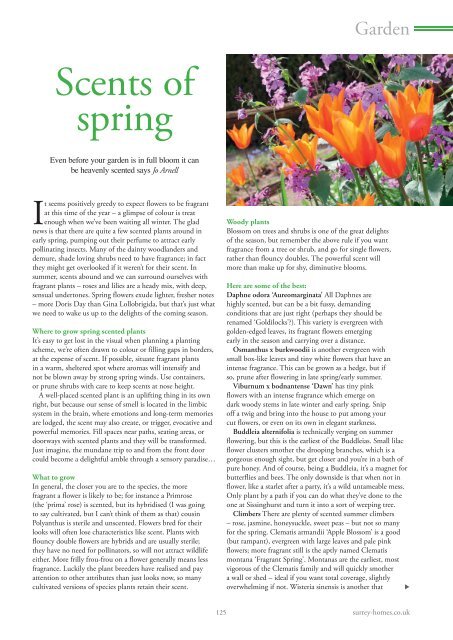Surrey Homes | SH41 | March 2018 | Fashion supplement inside
The lifestyle magazine for Surrey - Inspirational Interiors, Fabulous Fashion, Delicious Dishes
The lifestyle magazine for Surrey - Inspirational Interiors, Fabulous Fashion, Delicious Dishes
You also want an ePaper? Increase the reach of your titles
YUMPU automatically turns print PDFs into web optimized ePapers that Google loves.
Garden<br />
Scents of<br />
spring<br />
Even before your garden is in full bloom it can<br />
be heavenly scented says Jo Arnell<br />
It seems positively greedy to expect flowers to be fragrant<br />
at this time of the year – a glimpse of colour is treat<br />
enough when we’ve been waiting all winter. The glad<br />
news is that there are quite a few scented plants around in<br />
early spring, pumping out their perfume to attract early<br />
pollinating insects. Many of the dainty woodlanders and<br />
demure, shade loving shrubs need to have fragrance; in fact<br />
they might get overlooked if it weren’t for their scent. In<br />
summer, scents abound and we can surround ourselves with<br />
fragrant plants – roses and lilies are a heady mix, with deep,<br />
sensual undertones. Spring flowers exude lighter, fresher notes<br />
– more Doris Day than Gina Lollobrigida, but that’s just what<br />
we need to wake us up to the delights of the coming season.<br />
Where to grow spring scented plants<br />
It’s easy to get lost in the visual when planning a planting<br />
scheme, we’re often drawn to colour or filling gaps in borders,<br />
at the expense of scent. If possible, situate fragrant plants<br />
in a warm, sheltered spot where aromas will intensify and<br />
not be blown away by strong spring winds. Use containers,<br />
or prune shrubs with care to keep scents at nose height.<br />
A well-placed scented plant is an uplifting thing in its own<br />
right, but because our sense of smell is located in the limbic<br />
system in the brain, where emotions and long-term memories<br />
are lodged, the scent may also create, or trigger, evocative and<br />
powerful memories. Fill spaces near paths, seating areas, or<br />
doorways with scented plants and they will be transformed.<br />
Just imagine, the mundane trip to and from the front door<br />
could become a delightful amble through a sensory paradise…<br />
What to grow<br />
In general, the closer you are to the species, the more<br />
fragrant a flower is likely to be; for instance a Primrose<br />
(the ‘prima’ rose) is scented, but its hybridised (I was going<br />
to say cultivated, but I can’t think of them as that) cousin<br />
Polyanthus is sterile and unscented. Flowers bred for their<br />
looks will often lose characteristics like scent. Plants with<br />
flouncy double flowers are hybrids and are usually sterile;<br />
they have no need for pollinators, so will not attract wildlife<br />
either. More frilly frou-frou on a flower generally means less<br />
fragrance. Luckily the plant breeders have realised and pay<br />
attention to other attributes than just looks now, so many<br />
cultivated versions of species plants retain their scent.<br />
Woody plants<br />
Blossom on trees and shrubs is one of the great delights<br />
of the season, but remember the above rule if you want<br />
fragrance from a tree or shrub, and go for single flowers,<br />
rather than flouncy doubles. The powerful scent will<br />
more than make up for shy, diminutive blooms.<br />
Here are some of the best:<br />
Daphne odora ‘Aureomarginata’ All Daphnes are<br />
highly scented, but can be a bit fussy, demanding<br />
conditions that are just right (perhaps they should be<br />
renamed ‘Goldilocks’?). This variety is evergreen with<br />
golden-edged leaves, its fragrant flowers emerging<br />
early in the season and carrying over a distance.<br />
Osmanthus x burkwoodii is another evergreen with<br />
small box-like leaves and tiny white flowers that have an<br />
intense fragrance. This can be grown as a hedge, but if<br />
so, prune after flowering in late spring/early summer.<br />
Viburnum x bodnantense ‘Dawn’ has tiny pink<br />
flowers with an intense fragrance which emerge on<br />
dark woody stems in late winter and early spring. Snip<br />
off a twig and bring into the house to put among your<br />
cut flowers, or even on its own in elegant starkness.<br />
Buddleia alternifolia is technically verging on summer<br />
flowering, but this is the earliest of the Buddleias. Small lilac<br />
flower clusters smother the drooping branches, which is a<br />
gorgeous enough sight, but get closer and you’re in a bath of<br />
pure honey. And of course, being a Buddleia, it’s a magnet for<br />
butterflies and bees. The only downside is that when not in<br />
flower, like a starlet after a party, it’s a wild untameable mess.<br />
Only plant by a path if you can do what they’ve done to the<br />
one at Sissinghurst and turn it into a sort of weeping tree.<br />
Climbers There are plenty of scented summer climbers<br />
– rose, jasmine, honeysuckle, sweet peas – but not so many<br />
for the spring. Clematis armandii ‘Apple Blossom’ is a good<br />
(but rampant), evergreen with large leaves and pale pink<br />
flowers; more fragrant still is the aptly named Clematis<br />
montana ‘Fragrant Spring’. Montanas are the earliest, most<br />
vigorous of the Clematis family and will quickly smother<br />
a wall or shed – ideal if you want total coverage, slightly<br />
overwhelming if not. Wisteria sinensis is another that <br />
125 surrey-homes.co.uk


















